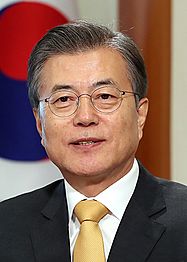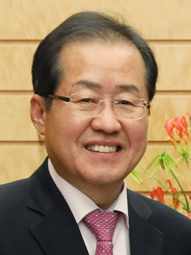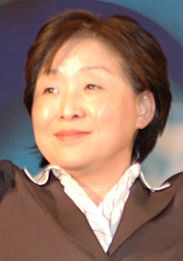South Korean presidential election, 2017 facts for kids
The 19th South Korean presidential election took place on 9 May 2017. This election happened earlier than planned. It was held because the previous president, Park Geun-hye, was removed from her job. This removal is called an impeachment and dismissal.
The election was originally set for 20 December 2017. However, South Korea's highest court, the Constitutional Court, decided on 10 March 2017 to agree with the parliament's decision to remove President Park. This made the election happen sooner.
Before April 2017, surveys showed that Moon Jae-in was the most popular candidate. He belonged to the Democratic Party. Moon Jae-in had also run in the 2012 election and came in second. He later won the 2017 election.
Contents
Who Ran for President?
Many people ran to become president. Here are the main candidates:
-
Moon Jae-in
(Democratic Party) -
Hong Jun-pyo
(Liberty Party) -
Ahn Cheol-soo
(People's Party) -
Yoo Seong-min
(Bareun Party) -
Sim Sang-jung
(Justice Party)
What Did People Think Before the Election?
Before the election, people were asked who they would vote for. This is called opinion polling. These polls helped show who was leading the race.
Election Results
The election results showed how many votes each candidate received. They also showed which candidate won in different parts of South Korea.
| Regions · Provinces · Cities |  |
 |
 |
 |
 |
||||||
|---|---|---|---|---|---|---|---|---|---|---|---|
| Moon Jae-in Democratic |
Hong Jun-pyo Liberty Korea |
Ahn Cheol-soo People's |
Yoo Seung-min Bareun |
Sim Sang-jung Justice |
|||||||
| Votes | % | Votes | % | Votes | % | Votes | % | Votes | % | ||
| Seoul National Capital Area | Seoul | 2,781,345 | 42.3 | 1,365,285 | 20.78 | 1,492,767 | 22.7 | 476,973 | 7.26 | 425,459 | 6.47 |
| Incheon | 747,090 | 41.2 | 379,191 | 20.9 | 428,888 | 23.7 | 118,691 | 6.54 | 129,925 | 7.16 | |
| Gyeonggi | 3,319,812 | 42.1 | 1,637,345 | 20.8 | 1,807,308 | 22.9 | 540,023 | 6.84 | 546,373 | 6.92 | |
| Gwandong (Gangwon) |
324,768 | 34.2 | 284,909 | 30.0 | 206,840 | 21.8 | 65,278 | 6.86 | 62,389 | 6.56 | |
| Hoseo (Chungcheong) |
Daejeon | 404,545 | 42.9 | 191,376 | 20.3 | 218,769 | 23.2 | 59,820 | 6.34 | 63,669 | 6.75 |
| North Chungcheong | 374,806 | 38.6 | 255,502 | 26.3 | 211,454 | 21.8 | 57,282 | 5.90 | 65,095 | 6.70 | |
| South Chungcheong | 476,661 | 38.6 | 306,614 | 24.8 | 290,216 | 23.5 | 68,521 | 5.55 | 83,868 | 6.79 | |
| Sejong | 77,767 | 51.1 | 23,211 | 15.2 | 32,010 | 21.0 | 9,192 | 6.03 | 9,353 | 6.14 | |
| Honam (Jeolla) |
Gwangju | 583,847 | 61.1 | 14,882 | 1.55 | 287,222 | 30.1 | 20,862 | 2.18 | 43,719 | 4.60 |
| North Jeolla | 778,747 | 64.8 | 40,231 | 3.34 | 285,467 | 23.8 | 60,802 | 2.56 | 29,296 | 4.93 | |
| South Jeolla | 737,921 | 59.9 | 30,221 | 2.45 | 378,179 | 30.7 | 25,819 | 2.09 | 49,509 | 4.01 | |
| Yeongnam (Gyeongsang) |
Busan | 872,127 | 38.7 | 720,484 | 32.0 | 378,907 | 16.8 | 162,480 | 7.21 | 94,329 | 4.85 |
| Ulsan | 282,794 | 38.1 | 203,602 | 27.5 | 128,520 | 17.3 | 60,289 | 8.13 | 62,187 | 8.38 | |
| Daegu | 342,620 | 21.8 | 714,205 | 45.4 | 235,757 | 15.0 | 198,459 | 12.60 | 74,440 | 4.72 | |
| North Gyeongsang | 369,726 | 21.7 | 827,237 | 48.6 | 253,905 | 14.9 | 149,017 | 8.75 | 88,080 | 5.17 | |
| South Gyeongsang | 779,731 | 36.7 | 790,491 | 37.2 | 284,272 | 13.4 | 142,479 | 6.71 | 113,051 | 5.32 | |
| Jeju | 169,493 | 45.5 | 68,063 | 18.3 | 77,861 | 20.9 | 22,784 | 6.11 | 31,716 | 8.51 | |
| Total | 13,423,800 | 41.08% | 7,852,849 | 24.03% | 6,998,342 | 21.41% | 2,208,771 | 6.76% | 2,017,458 | 6.17% | |
Images for kids
See also
 In Spanish: Elecciones presidenciales de Corea del Sur de 2017 para niños
In Spanish: Elecciones presidenciales de Corea del Sur de 2017 para niños









